 The information on this site is from one of the most famous books about the New Medicine (GNM / 5BN): "The Psychic Roots of Diseases" by Björn Eybl. Since September 2025, it is available in the form of an app with many additional features.
The information on this site is from one of the most famous books about the New Medicine (GNM / 5BN): "The Psychic Roots of Diseases" by Björn Eybl. Since September 2025, it is available in the form of an app with many additional features.It was written in german and was translated into more than 10 languages already. German is not freely available, as the rights are held by a publisher, but all these translations are available as ebooks / PDFs for free, as a gift of Björn for you, for the New Earth, for a new time.
In cooperation with Björn, it is splitted on "Disease is Different" into the sections by organ systems and combined with the real cases of our international testimonial / report archive of the related organ system.
EAR
The external ear (auris externa) is made up of the auricle (pinna), the earlobe (lobulus auricula), and the outer auditory canal (meatus acusticus externus). The ear- drum or tympanic membrane (membrana tempani) marks the division between the outer ear and the middle ear (auris media). The air-filled, tympanic cavity of the middle ear, with its hammer (malleus), anvil (incus) and stirrup (stapes), is connected via the eustachian tube with the pharyngeal cavity. In the oval window (fenstra ovalis), the stirrup transmits hearing impulses to the snail-shaped cochlea of the inner ear, which is the actual auditory organ. The semicircular canal is where the sense of balance is located.
Ear – Dermis
Disfigurement – hearing
Ear – Epidermis
Hearing–separation
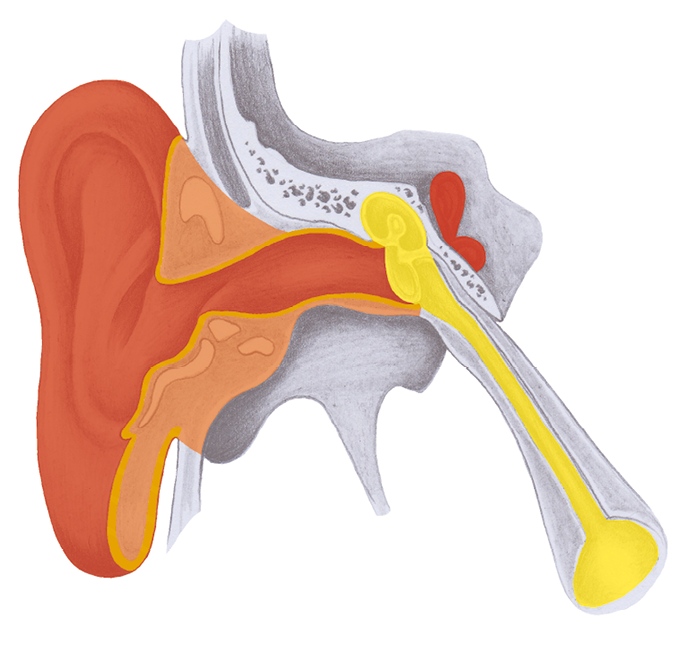
Ear – cartilage
Self-esteem (Hearing)
Inner ear – Vestibular System,
Semicircular Canal
Inability to control/balance,
falling conflict
Inner Ear – Cochlea
Hearing conflict
Middle Ear and
Eustachian Tube
Hearing chunk (survival)
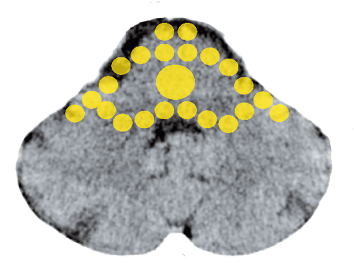
Middle ear infection (otitis media), inflamed ear polyp1
Inflammation of the bone behind the ear (mastoiditis)
The inflammation of the mastoid process occurs only in the context of a middle ear infection (otitis media). No wonder, since these air-filled bone cavities are also lined with endodermal middle ear mucosa.
Same SBS as above (see above).
1 See Dr. Hamer, Charts, pp. 18, 23

Eustachian tube dysfunction (ETD)
The auditory tube (Tuba auditiva, short “Tuba”) connects the middle ear with the throat. This important channel enables 1) the drainage of secretions from the middle ear and
2) pressure equalization (passively when swallowing and yawning or actively by holding the nose + blowing).
The tube is a highly complex structure of cartilage, a closure system with three (!) different muscles, also incorporating mucous membrane and glandular cells. The following conflict can be derived from its function:
| Conflict | See the conflict for the middle ear (p. 128) with the additional aspects: Not being able to get rid of the “crap” being heard, not being able to balance the pressure of what is heard (not being able to integrate what is heard). |
|---|---|
| Conflict active | Increase in function (and, in the case of prolonged conflict duration, cell growth) of the middle ear mucosa goblet cells. |
| Bio. function | With more mucus, the “crap” being heard can be excreted better. |
| Repair/healing | Tuberculous, caseating degradation of the thickened mucosa by fungi or bacteria. The secretion can flow into the throat or the middle ear where it may look like a middle ear infection. Swelling, pain, mild fever, night sweats. |
| Note | In chronic cases, the mucosa of the Eustachian tube increasingly thickens > occlusion > insufficient ventilation of the middle ear > retraction of the eardrum > poor hearing = recurrent or persistent conflict. |
| Therapy | Accompany the healing. If it is chronic, determine the conflict and conditioning and resolve. Questions, therapy p. 129. Warm saltwater compresses. Inhalations, oil pulling (p. 68). MMS (see p. 68). Lymph drainage (see p. 68). Kidney collection tube therapy measures p. 279. In very persistent cases, the ENT specialist must suck out the secretions or temporarily lay a tympanic tube for the drainage of mucus. |
Fluid accumulation in the middle ear (otitis media with effusion, tympanic effusion)
In this disease, fluid accumulates in the middle ear because the drainage through the Eustachian tube is blocked. Relatively common in children (often after tonsil surgery), rare in adults. Symptoms: Poor hearing, no detectable middle ear inflammation, feeling of “full ear,” little or no pain.
Two possible causes for a tympanic effusion:
1. Outflow obstruction due to inflammation/swelling in the HNO area (e.g. tonsils, nasal or pharyngeal mucosa or swelling after tonsillectomy). > Not its own SBS, but flow obstruction due to local pressure on the Eustachian tube or its opening into the nasopharynx. > Find out which structure is swollen (swelling = repair phase). > Identify conflict and, if recurring, resolve it permanently.
2. SBS of the Eustachian tube (see conflict above). If the tubal mucosa is not inflamed, the three muscles that control the valve at the exit to the throat may be playing the main role here. Therapy: see above.
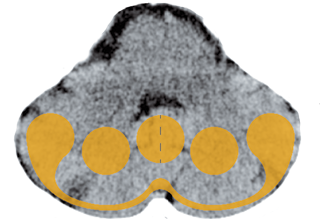
Tumor of the balance (vestibular) nerve – vestibular
schwannoma – mistakenly “acoustic neuroma“
Dr. Hamer groups the acoustic neuroma with the brain stem (see: p.128, middle ear infection), which seems correct, because the “tumor“ lies in the brainstem (although it is on the border to the cerebellum).
The reason I order this SBS, with the cerebellum – mesoderm, is because the tumor, when seen histologically, is made up of Schwann cells – thus a “nerve sheath tumor.” It grows around the vestibulocochlear nerve (balance nerve) between the cerebellopontine angle, inner ear canal and the inner ear.
Due to swelling, it can compact the vestibular (balance) nerve as well as the cochlear (hearing) nerve and trigeminal (facial) nerve.
| Conflict | Likely a “balance-pain conflict.” Painful/burdensome/negative information knocks one off balance. |
|---|---|
| Example | ➜ One must work with a jackhammer every day. Every time her grown daughter comes to visit, the right-handed mother hears a sermon about everything she has done wrong and what she should have done differently = balance-pain conflict. She can no longer listen to her daughter‘s harping and wishes she could have some understanding of her problems. Over the years, an acoustic neuroma develops on the left mother/child ear = active–phase. The patient‘s symptoms: deafness and dizziness. The neuroma is removed through surgery. (Archive B. Eybl) Every time her grown daughter comes to visit, the right-handed mother hears a sermon about everything she has done wrong and what she should have done differently = balance-pain conflict. She can no longer listen to her daughter‘s harping and wishes she could have some understanding of her problems. Over the years, an acoustic neuroma develops on the left mother/child ear = active–phase. The patient‘s symptoms: deafness and dizziness. The neuroma is removed through surgery. (Archive B. Eybl) |
| Conflict-active | Growth of a vestibular Schwannoma in the cerebellopontine angle. The longer the conflict lasts, the greater it becomes. Symptoms: deafness on one or both sides, disturbances in the sense of balance, dizziness. |
| Bio. function | Through the thickening of the nerve insulation, the unbearable information is blocked. |
| Repair phase | Inflammation > worsening of the symptoms. Break down of the tumor by bacteria. Restoration is possible, but only in the preliminary phase when the tumor is very small. After a certain size, its degeneration is unrealistic. The best possible scenario is a stoppage in growth. |
| Questions | Diagnosed when? (The conflict-active phase can already have been going on for months/years). What has been putting me off balance for a long time? What do I want to block unconsciously? What am I unable to “tune out?” If these questions remain unanswered: What bothers me the most in my life and has for a long time now? Which conditioning and character traits are the cause? (E.g. oversensitivity, absence of stability)? Which ancestors are similar? What made them become like that? |
| Therapy | Find out what the conflict and conditioning are and, if possible, resolve them. Find out where the love is – there you’ll find the solution. Guiding principle: “I have the power to change the things that are unhealthy for me.” If the tumor continues to grow or is already too big, an OP is unavoidable. |
Inflammation of the outer ear or auditory canal (otitis externa)
| Conflict | Wanting to hear something desirable or not wanting to hear something undesirable. Wanting or not wanting to have skin contact at the ear (local conflict). |
|---|---|
| Example |  In a long telephone call with a friend, the patient gets an “earful“ of verbal abuse. During his friend‘s diatribe, he was eating nuts. Since then, he is allergic to nuts (= trigger). One day after eating nuts, he suffers from itchy eczema in his ear during the repair phase. (Archive B. Eybl) In a long telephone call with a friend, the patient gets an “earful“ of verbal abuse. During his friend‘s diatribe, he was eating nuts. Since then, he is allergic to nuts (= trigger). One day after eating nuts, he suffers from itchy eczema in his ear during the repair phase. (Archive B. Eybl)➜ Someone likes it when their cat lovingly rubs their ear. The cat dies = separation conflict of losing skin contact at the ear. |
| Conflict-active | Cell reduction in the squamous epithelium of the outer ear or the auditory canal. Scaly, dry, numb skin, lessening of sensitivity, no pain. |
| Bio. function | Through lessening of sensitivity, the separation is more easily forgotten or the unwanted contact is “blocked out.“ |
| Repair phase | Inflammation of the outer ear or auditory canal. Replenishing and filling up of the squamous epithelium, over-sensitivity. Rash on the ear, itching ear canal eczema, scaling off of the outer skin (detritus) because new cells are pushing out from below. |
| Note | Consider “handedness“ (right or left) and side (mother/child or partner) or local conflict. |
| Questions | When did it begin? (Previously, a hearing conflict must have been resolved). What didn’t I want to hear? (Accusations, viscous words, criticism)? What stressed me? Did it have anything to do with a specific person? |
| Therapy | The conflict is resolved. Support the healing. If recurrent, determine the conflict and/or conditioning. Guiding principles: “I do not expect anything.“ “I am happy with the way it is.“ “I say YES to life!“ Compresses and herbs: see middle–ear infection. Drops of the juice of the houseleek (sempervivum tectorum) in the ear. Sloughed off skin can lead to inflammation. Therefore, if necessary, clean the ear canal regularly with an ear bath or let the doctor clean it. MMS (see p. 68). |
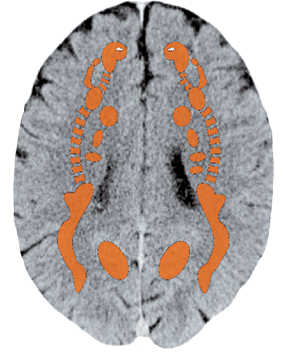
Inflammation of the outer ear cartilage (auricular perichondritis), gout
| Conflict | Self-esteem conflict with regard to the ear or the taking in of sound + active kidney collecting tubules. |
|---|---|
| Example | ➜ Somebody has a hearing impairment and can no longer follow the conversation at the table. |
| Conflict-active | Cell degradation in cartilage, no pain. |
| Repair phase | Restoration of the cartilage. Inflammation of the auricular cartilage. Swelling, reddening, pain. In the case of syndrome (see p. 277ff), “gout tophus“ on the auricular cartilage. |
| Bio. function | Strengthening of the cartilage so that sound can be better absorbed. |
| Note | With this SBS we are dealing with “gout in the ear.“ Consider “handedness“ (right or left) and side (mother/child or partner) or local conflict. E.g., partner always sits on one side and gives you an ear full. |
| Therapy | The conflict is resolved. Support the healing. In the case of recurrences, determine the conflict and conditioning. Resolve any refugee conflict. Lay curd cheese or white cabbage leaves on the affected area. Cold compresses, cold showers. Spray the ear with tincture of frankincense or myrrh. MMS (see p. 68). |
Tensor Tympani
Inability to dampen the noise
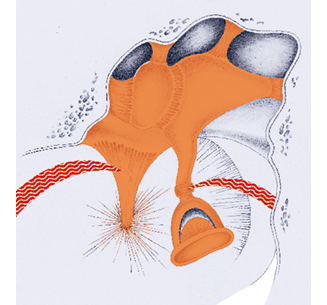
Stapedius Muscle
Inability to dampen noise
Deafness caused by the tympanic muscle and the stapedius muscle
These two muscles of the middle ear tense up in order to reduce the vibration of the eardrum, thereby protecting it from high sound levels. Sometimes, explosions and the like cannot be “intercepted,“ because the reaction time is too short. Thus, these and similar sounds can hurt the inner ear and cause deafness.
According to CM, voluntary (striated) muscles are involved here (one really can tense up the ear drum when a loud noise is expected). Normally, however, the two muscles behave involuntarily, as if they were smooth muscles. It is interesting to note that they also react in the same way (as if they were involuntary muscles) in the case of a conflict.
| Conflict | Not being able to dampen the noise. (E.g., A wife complains constantly, someone with dementia constantly repeats the same thing, a coworker sings annoyingly the whole day long). |
|---|---|
| Examples |  Thirty years ago on New Year‘s Eve, a firecracker exploded next to the now 67-year-old patient = conflict of not being able to silence the sound. For four months, he had trouble hearing with the right ear = active–phase with increased tension of the tympanic membrane and the stapedius muscle. After that, his hearing normalized again = repair phase. Since then, however, any loud noise – such as a truck driving by or the noise of a concert – causes several minutes of deafness = recurrence with muscle tension. Hearing tests show that the patient has excellent hearing. (Archive B. Eybl) Thirty years ago on New Year‘s Eve, a firecracker exploded next to the now 67-year-old patient = conflict of not being able to silence the sound. For four months, he had trouble hearing with the right ear = active–phase with increased tension of the tympanic membrane and the stapedius muscle. After that, his hearing normalized again = repair phase. Since then, however, any loud noise – such as a truck driving by or the noise of a concert – causes several minutes of deafness = recurrence with muscle tension. Hearing tests show that the patient has excellent hearing. (Archive B. Eybl)➜ Someone works in a nightclub and suffers from constant noise. ➜ Someone constantly “gets an earful“ from their partner. |
| Conflict-active | Increase in the muscle tension (hypertonia) of the tympanic muscle and/or stapedius muscle > deafness. Permanent deafness due to persistent conflict activity > constant tension. (Behaves like involuntary muscle?) |
| Bio. function | Damping of the sound. |
| Repair phase | Restoration of normal hearing. |
| Repair crisis | “Cracking” in the ear due to uncoordinated contractions of the aforementioned muscles. |
| Note | Behavior of involuntary muscles: Could it be that those striated muscles that also operate involuntarily (for instance the diaphragm, the outer eye muscles) might react like involuntary muscles in the case of conflict? |
| Questions | Was there a specific, extreme noise event or is something chronically annoying? (Office, particular people)? In which situations is it better/worse? (Indication of the conflict). |
| Therapy | Determine the conflict and conditioning and, if possible, resolve them in real life. Guiding principles: “Now the noise does not bother me anymore. It could be worse. I am ready to hear everything again.“ Bach flowers (see p. 59): beech, crab apple, lymph drainage massages (see p. 68), acupuncture, acupoint massage (see p. 68). |

Ear canal furuncle (otitis externa circumscripta)
Inflammation of a hair follicle in the auditory canal.
| Conflict | Disfigurement conflict. Conflict of feeling deformed or disfigured. Feeling disfigured by what one has heard. |
|---|---|
| Example | ➜ Somebody gets verbally abused. ➜ The patient suffers from an overproduction of earwax. The partner complains about the bad smell coming from the ear = disfigurement conflict. (Archive B. Eybl) |
| Conflict-active | A thickening of the dermis (corium) that usually goes unnoticed. |
| Bio. function | Better protection from disfigurement through thickened dermis. |
| Repair phase | Inflammation. Tubercular, caseating, stinking deterioration of the tumor (pus). |
| Note | Danger of vicious circle due to stinking ear. Sometimes histamines (see: p.167) or certain foods (see p. 88) may be a trigger. |
| Questions | When did the symptoms begin? Which stress did I have before this? By what did I feel attacked? Is is based on my nutrition? (Trigger). Which stress did I have before the last episode of itchiness? |
| Therapy | The conflict is resolved. Support the healing. In case of recurrence, determine the conflict and conditioning. Bathe the auditory canal or clean with an ear spoon to eliminate recurrences. DMSO (dimethylsulfoxide), H2O2 externally. If recurring, guiding principles: “A crystal wall surrounds me.“ “That goes in one ear and out the other.“ “I will remain in my center.” Bach Flowers: crab apple, compresses and herbs (see middle ear infection). |
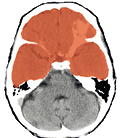
Impairment due to the inner ear, sounds in the ear (tinnitus)1
| Conflict | Not wanting the hear something. The most common hearing impairment SBS. |
|---|---|
| Examples | ➜ “What I am hearing cannot be true! » I cannot believe what I‘m hearing! This guy is pestering me!“ A youthful, 50-year-old, right-handed woman has been suffering from tinnitus of the right ear and dizziness for the last 5 days. Conflict history: The patient has a 53-year-old sister with psychological problems. Following a 4-month stay in a psychiatric clinic, her condition seems stable. Six days ago, the patient was invited by her sister to have breakfast together. She notices at once that her sister is in very bad shape again, as she constantly pokes around in her miserable past > hearing conflict: “I just can‘t listen to this anymore!“ and falling conflict: “She will never stabilize!“ To the patient, it is clear that her sister will never get out of this mess. Therapy: she tries to lay her sister‘s fate in the hands of God. (Archive B. Eybl) A youthful, 50-year-old, right-handed woman has been suffering from tinnitus of the right ear and dizziness for the last 5 days. Conflict history: The patient has a 53-year-old sister with psychological problems. Following a 4-month stay in a psychiatric clinic, her condition seems stable. Six days ago, the patient was invited by her sister to have breakfast together. She notices at once that her sister is in very bad shape again, as she constantly pokes around in her miserable past > hearing conflict: “I just can‘t listen to this anymore!“ and falling conflict: “She will never stabilize!“ To the patient, it is clear that her sister will never get out of this mess. Therapy: she tries to lay her sister‘s fate in the hands of God. (Archive B. Eybl)  A 41-year-old, right-handed man has a good position as the manager of a hotel. One day, his supervisor informs him that the hotel is about to be closed. It is clear to the patient that this means the end of his job > hearing conflict: “What I have just heard cannot be true!“ Since this point he has suffered from tinnitus in both ears. (Archive B. Eybl) A 41-year-old, right-handed man has a good position as the manager of a hotel. One day, his supervisor informs him that the hotel is about to be closed. It is clear to the patient that this means the end of his job > hearing conflict: “What I have just heard cannot be true!“ Since this point he has suffered from tinnitus in both ears. (Archive B. Eybl) |
| Conflict-active | Reduced functioning of the inner ear = deafness and/or humming, rustling, hissing, whistling, ringing in the ear = tinnitus. This causes further hearing reduction. |
| Bio. function | Blocking out of what is being heard through a reduced functioning of the inner ear. Tinnitus: one is warned when the same or a similar situation recurs. The tinnitus noise also helps to disrupt the unbearable quiet when someone is all alone. (The sound of the seashore in a shell provides comfort and a sense of connection). |
| Repair phase | Often, one notices the tinnitus only after acute hearing loss: Here, there may be a chronic hearing conflict present, which just went into the repair phase (hearing loss) recently. Sudden deafness (see ISSHL below) followed by slow recovery of hearing, hearing impairment due to recurrences or persistent repair. |
| Note | • Tension in the neck muscles may aggravate tinnitus or even cause it. • Words, sentences or songs that repeatedly go through our heads also function according to this scheme (word – tinnitus, music – tinnitus = “stuck in the head“). |
| Questions | For hearing impairment: since when? (Previous conflict, usually continuing up to the present). What could I no longer tolerate hearing, which situations got on my nerves? Am I resisting listening because it might hurt? (Criticism, objections)? Am I constantly transmitting and not receiving? Do/did my ancestors also have impaired hearing? Is there someone who I am similar to? (Indication of a family issue). For tinnitus: Since when? Which sounds/which situations does my tinnitus noise remind me of? In which situations does it get worse? (Indication of the conflict). When does it get better? (Weekends, vacation or mornings, when I am together with certain people? > Indication of the conflict). |
| Therapy | Determine the conflict and conditioning and, if possible, resolve them in real life. Guiding principle: “It‘s a good thing that I heard that, but now, it’s already forgotten.“ Disconnect-ritual: “Say goodbye“ to the hearing conflict with your heart and mind. Lymph drainage massages (see p. 68). Acupuncture, acupoint massage (see p. 68). Willfort: smoke ear with hyssop fumes. Tea: club moss, mistletoe, hyssop violets. MMS (see p. 68). Hydrogen peroxide (H2O2) 3% internally. In CM, in cases of acute tinnitus, high doses of cortisone are prescribed over several days. It makes more sense to practice the so-called tinnitus retraining therapy (TRT). |
Acute hearing loss (sudden deafness)2
Same SBS as above. Sudden deafness ranging from slight hearing loss to total deafness, usually in just one ear and without pain. It can affect all or only certain frequencies.
| Repair phase | Edema in the inner ear and in the hearing center of the meninges > short-term, severe reduction of hearing ability. In my experience, the order of tinnitus preceding acute hearing loss first isn’t substantiated very often. Usually, it is the reverse (still unclear). What is clear is that the hearing conflict needs to be determined and resolved. |
|---|---|
| Therapy | The conflict has been resolved. Support the healing process. Guiding principles: “Relax, the symptoms are temporary.“ Alkaline food, lymph drainage massages (see p. 68), hydrogen peroxide (H2O2) 3% internally. MMS (see p. 68). In CM, circulation stimulating, blood-thinning medication and cortisone is administered. From the view of the New Medicine, this is only sensible as a short-term treatment. Personally, I would only apply the measures described above. |

Otosclerosis (otospongiosis)
Ossification can affect the oval window, the round window, the cochlea or the semicircular canals. The disease pattern is usually as follows: The normally moveable stirrup bone (stapes) becomes increasingly fixed in place > less transmission of sound waves > deafness.
Hearing impairment (hypacusis)
Possible causes
• Poisoning due to drugs or medication: Antibiotics, diuretics, painkillers, acetylsalicylic acid (ASA) in high doses, psychotropic, chemotherapeutic substances, anti-malaria medication, iodine (as an additive to salt, toothpaste, etc.) can cause hearing impairment.
• Cochlea hearing conflict: Not wanting to hear something. In persistent conflict activity > hearing impairment due to reduced function of the inner ear and/or tinnitus. In the repair phase > impaired hearing due to edema of the inner ear (acute hearing impairment) see: p.134.
• Middle ear mucosa or mucosa of the eustachian tube = hearing chunk conflict (see explanations p. 15, 16). Hearing impairment due to recurring infection. Scarring with calcium deposits in the middle ear > impaired functioning of the hearing bones. See: p.128.
• Middle ear muscles: Self-esteem conflict, not being able to silence a noise. Possible hearing impairment in the conflict-active phase. See: p.135.
• Bony labyrinth: Self-esteem conflict. Not being able to hear well. Impaired hearing in persistent repair or after many instances of conflict (recurrence). See: p.135.
• Mechanical closure of the outer auditory canal due to ear wax (cerumen). Noticeable worsening after coming in contact with water. Upwelling of ear wax.
Determining which of these various causes is the actual one isn’t always clear. The easiest is the explanation of the middle ear SBS: Here, several middle ear infections must already have taken place. Tinnitus is a clear indication of the second possible cause.
Therapy
- Determine the conflict and conditioning and, if possible, resolve them in real life.
- Mix dry mustard with water and paint it behind the ear (stimulates circulation)
- Garlic and lemon drink cure.
- Acupuncture or acupoint massage (see p. 68), lymph drainage massages (see p. 68).
- Natural borax internally.
- Hydrogen peroxide (H2O2) 3% internally.
Ménière‘s disease (MD)
CM’s triad of symptoms for Ménière‘s disease is made up of the following symptoms: vertigo, one-sided hearing loss and tinnitus. Here, CM forms a single “disease“ out of at least two separate SBSs in different phases.

Dizziness (vertigo) caused by a falling conflict1
| Conflict | Falling or balance conflict. A person sees someone fall or falls himself. Also in the figurative sense: to lose one‘s grip or balance. To lose the ground beneath one‘s feet. Hang in the air. Fall in a hole. “It made me fall off my seat!” “He fell down off his high horse!” Further aspect: swindle comes from the German schwindeln (to make) dizzy. Thus, this also includes the concepts (experienced passively or actively): lying, manipulation, twisting (truth), embellish/sugar coat, being unfaithful/disloyal. Tendency to deny reality, often be flighty, absent-minded. |
|---|---|
| Example |  Due to her low and irregular income, the 40-year-old patient can barely afford an apartment. After hearing a lecture about the upcoming dramatic economic crisis, she has the feeling that she is losing the ground beneath her feet (= falling conflict). For two weeks, she was so dizzy that she can hardly walk or drive (= conflict-active phase). She resolves the conflict by deciding to move in again with her estranged partner. Immediately after she makes this decision, the dizziness ceases. (Archive B. Eybl) Due to her low and irregular income, the 40-year-old patient can barely afford an apartment. After hearing a lecture about the upcoming dramatic economic crisis, she has the feeling that she is losing the ground beneath her feet (= falling conflict). For two weeks, she was so dizzy that she can hardly walk or drive (= conflict-active phase). She resolves the conflict by deciding to move in again with her estranged partner. Immediately after she makes this decision, the dizziness ceases. (Archive B. Eybl)  In a 55-year-old woman, dizziness occurs whenever she cannot maintain her day/night (sleep) rhythm. She then feels off center or out of balance. When she recognizes this connection, she does not let anything, no matter how important, distract her from her planned, ideal bedtime. The dizziness subsides completely. (Archive B. Eybl) In a 55-year-old woman, dizziness occurs whenever she cannot maintain her day/night (sleep) rhythm. She then feels off center or out of balance. When she recognizes this connection, she does not let anything, no matter how important, distract her from her planned, ideal bedtime. The dizziness subsides completely. (Archive B. Eybl) A 62-year-old, now divorced woman experienced a financial disaster with her husband. For several months, this religious woman has been tormented by one thought: “Should I declare personal bankruptcy or not?” = conflict of losing the ground under her feet. The dizziness gets even worse when she learns that her son has been hospitalized. CM therapy with cortisone, and also homeopathic treatment, does not bring any improvement. When she realizes the connections, she uses regular meditation to “put everything in God’s hands.” By doing so, even though the bankruptcy decision is still pending, her dizziness decreases by 80%. (Archive B. Eybl) A 62-year-old, now divorced woman experienced a financial disaster with her husband. For several months, this religious woman has been tormented by one thought: “Should I declare personal bankruptcy or not?” = conflict of losing the ground under her feet. The dizziness gets even worse when she learns that her son has been hospitalized. CM therapy with cortisone, and also homeopathic treatment, does not bring any improvement. When she realizes the connections, she uses regular meditation to “put everything in God’s hands.” By doing so, even though the bankruptcy decision is still pending, her dizziness decreases by 80%. (Archive B. Eybl) |
| Conflict-active | Impaired function of the equilibrium organ (vestibular apparatus) > dizziness, possibly a tendency to fall. In my experience, the dizziness doesn’t always occur immediately after the conflict, but rather after the first relaxation phase thereafter. |
| Bio. function | Dizziness causes someone to return to safe territory and avoid dangers = protection from further falls. |
| Repair phase | Disappearance of the dizziness. |
| Questions | 1. Side effects of medication? (Check if the beginning of the symptoms corresponds with ingestion. > Discontinue use as necessary). 2. Dizziness since when? (Conflict previous). 3. Determine if the dizziness occurred in sympathicotonia (active falling conflict) or in vagotonia (pressure on the brain – general repair symptom). Headaches? (= Indication of vagotonia). Cold/warm hands? Poor/good sleep? Appetite? Thinking in circles? If in sympathicotonia: Falls, accidents in the period in question? Lost footing/rug pulled out from underneath – by what? If in vagotonia: How did I come into the repair phase? Which stress did I have before this? Do ancestors also suffer from dizziness? If yes, what similarities in character are there? Do I want to relive this pattern or will I take the liberty to go my own way? |
| Therapy | Determine the conflict and conditioning and, if possible, resolve them in real life. Consider “handedness“ (right or left) and side (mother-child or partner). Avoid risk & stay on safe terrain. Guiding principle: concentrate on safety in one‘s life. “Grounding“ activities such as gardening, handwork, walking (barefoot), strength training, grounding ritual, lemon-garlic drink cure. Bach flowers (see p. 59): clematis, aspen, cerato, scleranthus, honeysuckle. Tea: St. John‘s wort, mistletoe. |
1 See Dr. Hamer, Charts, pp. 141,145
Dizziness – other causes
- Poisoning with drugs or medication: Antihypertensives (beta blockers, ACE inhibitors), pain killers (analgesics), epilepsy medication (antiepileptics), tranquilizers, antidepressants, cramp releasing medication (spasmolytics), antibiotics, antimycotics (anti-fungus medication), diuretics, anti-allergy medication (antihistamines), X-ray contrast media, etc. > Due to poisoning, the human body experiences artificial stress (sympathicotonia) > “success of the medication“ > If the body neutralizes or expels the toxins later on, it actually enters a repair phase (vagotonia) > dizziness, headache.
- Brain pressure = general healing symptom: The interaction of the eyes, balance organs (inner ear), and muscle and joint receptors, is disturbed by the swelling in the brain (brain pressure) > dizziness. See: p.67
- Cervical spine or skull bone in the repair phase (possibly in persistent repair), space requirement reaching into the inner-ear area > dizziness, see: p.362.
- Tumor on the hearing or balancing nerve > dizziness, see 131.
- High blood pressure, see: p.80.
- Hypoglycemia see: p.272.
All experience reports on the organ system « Ear » from the International Report Archive:
| Author | Title and Overview | Keywords | ||||
|---|---|---|---|---|---|---|
2025/08/06   My younger brother doesn't like being alone, he's always happy when he can either call me or visit me. Despite the fact that he lives many hours away by car, he would come to see me regularly and stay for 3, 4 or 5 days... | ||||||
 | 2024/12/13   Short-term impairment of hearing in the right ear after I was finally able to hear what I wanted. | middle ear, Eustachian tube, hearing chunk conflict | ||||
 | 2024/12/12   In spring 2024, I wanted to visit my father-in-law in the hospital. Weeks before, I heard a rumor that some hospitals in Austria were again taking “C”-like measures | |||||
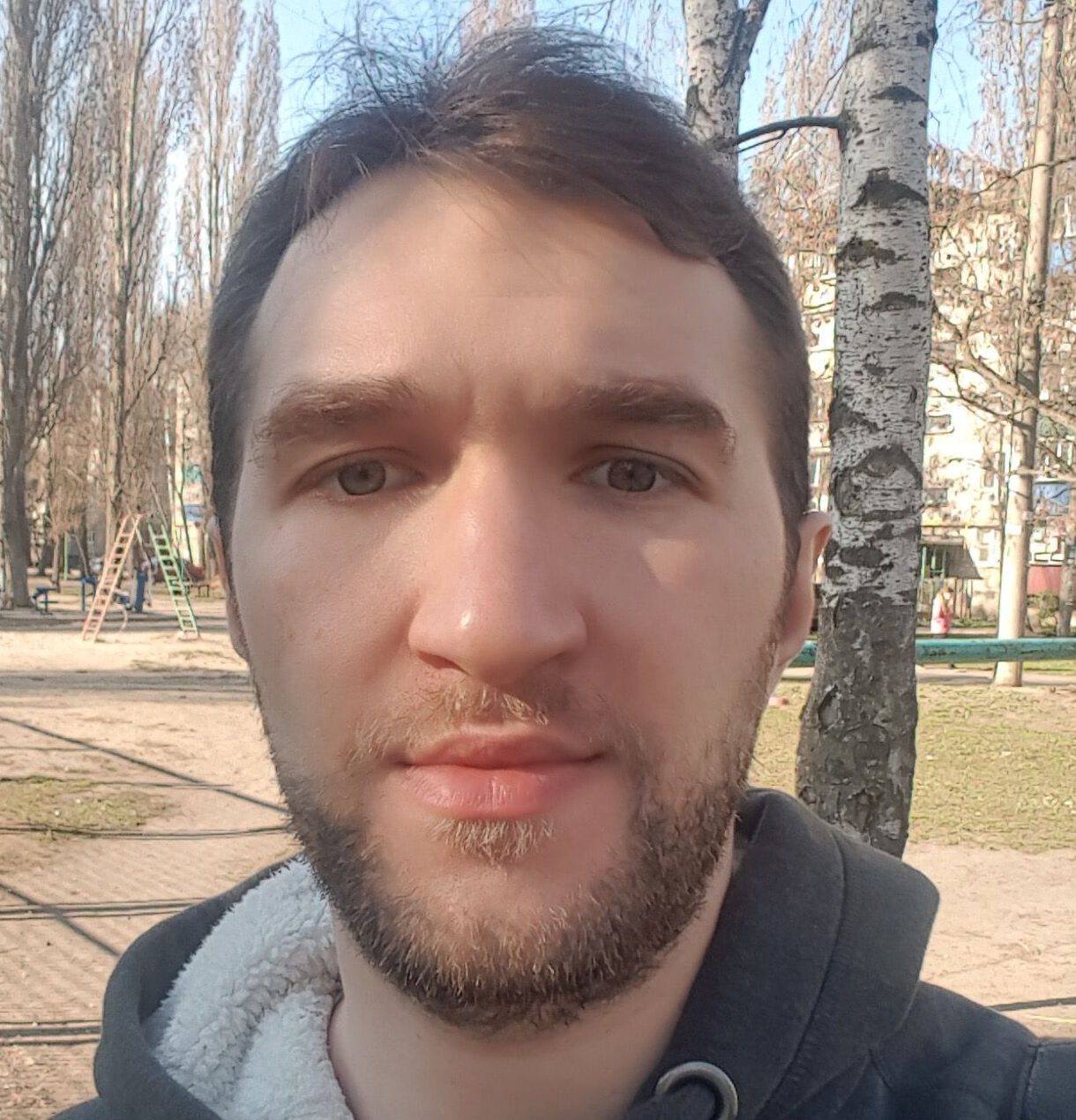 | 2024/11/13    I worked with a woman. 34 years old. Right-handed. Normal hormonal status. Symptoms: noises (tinnitus), special effects in both ears (auditory hallucinations), especially strong before bedtime (interfered with sleep). Hearing constellation (2 conflicts "I don't believe my ears?") ... | |||||
 | 2024/10/21   It's about our daughter, who was 4.5 years old at the time. We set off 3 days earlier from home into the unknown, with our car and trailer “Wohni” | |||||
2024/10/09   A participant from our learning group, who is right-handed, had the following tinnitus experience: one week her son had increased problems with homework etc., so she told him to take his cell phone away until he had finished his homework. This was virtually the “maximum punishment” for him and represented a minor hearing conflict concerning the ectodermal hearing function of the cochlea ... | Ringing in the ears, hearing conflict | |||||
2024/09/14   When I was 14, I was delighted to get a piercing in my ear and wore an earring with pride. In my mid-twenties, I wanted a second one, went to the jeweler and got one pierced ... | ||||||
2024/08/21   We were on an excursion at lunchtime when suddenly a jet fighter flew relatively low over us with an enormous noise. Our son got a huge fright and was totally terrified for 20 minutes... | ||||||
2024/08/21   Three occurrences of a plug in the right ear canal due to loud tantrums/screaming of children. | ||||||
 | 2024/07/06   For weeks, even months, I had been looking forward with mixed feelings to an announced, probably necessary gum graft in the lower jaw (to stabilize a certain implant) ... | |||||
 | 2023/11/19   On October 20, a patient (69 years old, LH) came to see me because she had severe positional vertigo and it was causing her great anxiety and restlessness. She had been to the doctor the days before and had been given morning exercises, which had improved the dizziness somewhat. Now she wanted to look at the issue with me after the 5 BN and together we quickly found the cause: ... | |||||
 | 2022/07/25    One day, blood and a thin, light-yellowish-beige secretion came out of a client's ear. The blood had a certain smell (and the cause was therefore already identifiable!). There was no pain. | "attack against the ear" conflict | ||||
 | 2021/06/16    Hearing loss in the left ear from an early age. After decades solution with strong middle ear infection: At the end, the hearing ability came back to a reduced extent. | |||||
2020/01/20     10 years ago, the now 35-year-old had a boss who bullied his employees wherever he could. There she reacted with the SBS of the mucous membrane of the Eustachian tube on the left, so she had to "listen to get rid of the danger/the predator/...", which happened daily at work at that time. Years later, when this one suddenly surprised her by phone and wanted to hire her again, she made it clear that she will NEVER work for him again and she never wants to hear him again, which led to the resolution of this old massive conflict. The now following 3 weeks duration of the severe symptoms could be accurately predicted. | ||||||
2018/11/17     Mr. R was middle-aged and woke up on Wednesday, 10/17/2018, with a slight hearing loss in his left ear: he could clearly notice that all lower frequencies were no longer perceptible. There was also a deep, clearly noticeable tinnitus sound. The symptoms lasted two and a half days. | ||||||
2018/01/30     The affected woman had a coffee allergy for about 15 years. Almost immediately after drinking coffee or eating food containing coffee, very severe stomach pain with nausea occurred, which lasted up to several hours. By researching the causes, the allergy was subsequently successfully resolved completely and permanently. | ||||||
 | 2014/12/28   In the middle of 2013, I was invited to our director's birthday party. (I do music cabaret full-time) Friends played a live musical act for our director there, which I found horrible ... |
